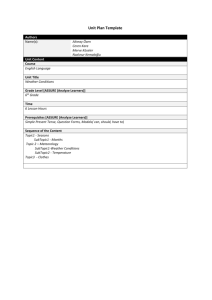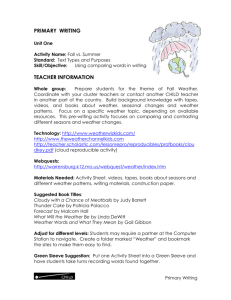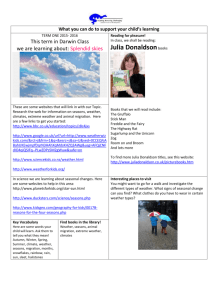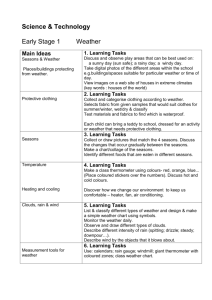Grade 2 – Weather
advertisement
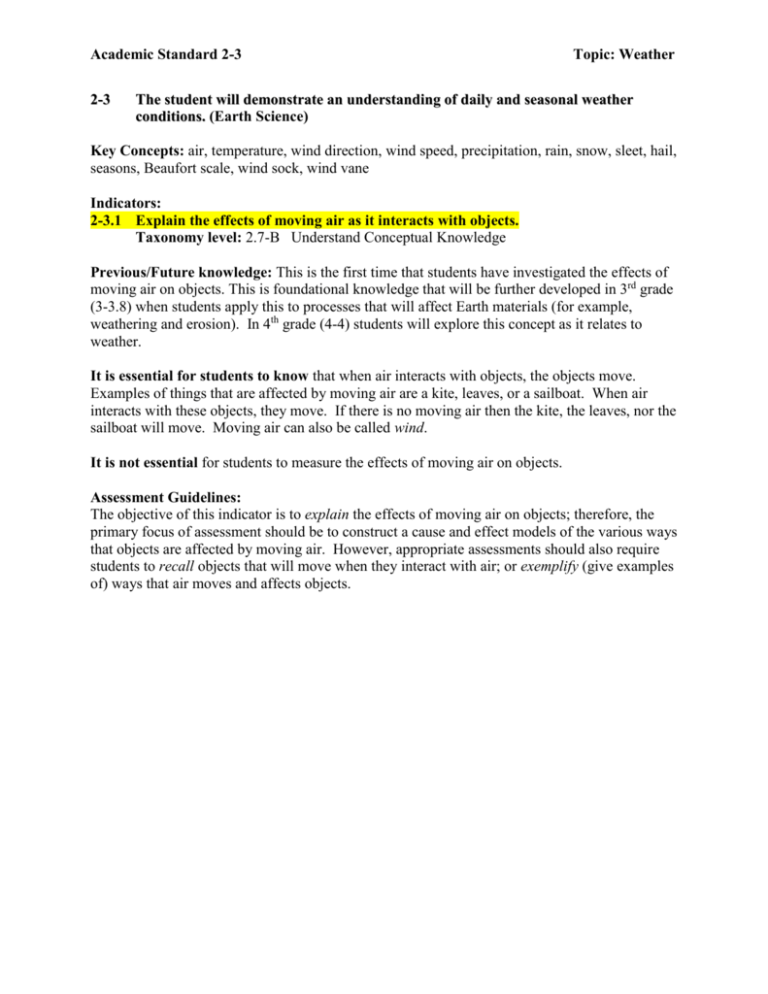
Academic Standard 2-3 2-3 Topic: Weather The student will demonstrate an understanding of daily and seasonal weather conditions. (Earth Science) Key Concepts: air, temperature, wind direction, wind speed, precipitation, rain, snow, sleet, hail, seasons, Beaufort scale, wind sock, wind vane Indicators: 2-3.1 Explain the effects of moving air as it interacts with objects. Taxonomy level: 2.7-B Understand Conceptual Knowledge Previous/Future knowledge: This is the first time that students have investigated the effects of moving air on objects. This is foundational knowledge that will be further developed in 3rd grade (3-3.8) when students apply this to processes that will affect Earth materials (for example, weathering and erosion). In 4th grade (4-4) students will explore this concept as it relates to weather. It is essential for students to know that when air interacts with objects, the objects move. Examples of things that are affected by moving air are a kite, leaves, or a sailboat. When air interacts with these objects, they move. If there is no moving air then the kite, the leaves, nor the sailboat will move. Moving air can also be called wind. It is not essential for students to measure the effects of moving air on objects. Assessment Guidelines: The objective of this indicator is to explain the effects of moving air on objects; therefore, the primary focus of assessment should be to construct a cause and effect models of the various ways that objects are affected by moving air. However, appropriate assessments should also require students to recall objects that will move when they interact with air; or exemplify (give examples of) ways that air moves and affects objects. Academic Standard 2-3 Topic: Weather 2-3.2 Recall weather terminology (including temperature, wind direction, wind speed, and precipitation as rain, snow, sleet, and hail). Taxonomy level: 1.2-A Remember Factual Knowledge Previous/Future knowledge: In kindergarten (K-4.2), students compared daily weather patterns. This is the first time that students have been introduced to formal weather terminology. This concept will be further investigated in 4th grade (4-4) when students summarize the conditions and effects of severe weather phenomena (including thunderstorms, hurricanes, and tornadoes) and related safety concerns and in 6th grade (6-4) the student will demonstrate an understanding of the relationship between Earth’s atmospheric properties and processes and its weather and climate. It is essential for students to know that weather conditions can be described using specific weather terminology. Temperature How warm or cold the air is at a given time. Each day the high and low temperatures are recorded. Wind direction The direction from which the wind blows Wind speed How fast or slow the wind blows. Precipitation The type of water falling from the clouds as rain, snow, sleet, or hail It is not essential for students to know other weather terminology at the grade. Students do not need to know the stages of the water cycle or the types of clouds found in the sky. Assessment Guidelines: The objective of this indicator is to recall weather terminology; therefore; the primary focus of assessment should be to retrieve this information from memory. However, appropriate assessments should also require students to identify each weather term or recognize weather terminology by definition. Academic Standard 2-3 Topic: Weather 2-3.3 Illustrate the weather conditions of different seasons. Taxonomy level: 2.2-A Understand Factual Knowledge Previous/Future knowledge: In kindergarten (K-4.2), students compared weather patterns that occurred from season to season. This concept will be further investigated in 4th grade (4-4.3) when students compare daily and seasonal weather patterns and in 6th grade (6-4.6) when they predict weather conditions or patterns. It is essential for students to know that each season has different weather patterns. There are four basic seasons winter, spring, summer, and fall/autumn. For students moving into our communities that are not native to South Carolina, they may come from areas that do not experience the four seasons that we do. Many areas only experience two definite seasons so be aware of this during instruction. It is not essential for students to know air pressure or humidity conditions. They do not need to understand seasons form the astronomy perspective-revolution around the Sun and tilt of Earth’s axis. Assessment Guidelines: The objective of this indicator is to illustrate weather conditions of different seasons; therefore, the primary focus of assessment should be to give examples or illustration the weather conditions from different seasons. However, appropriate assessments should also require students to recall the four basic seasons; identify different seasonal weather conditions; or recognize different seasonal weather conditions Academic Standard 2-3 Topic: Weather 2-3.4 Carry out procedures to measure and record daily weather conditions (including temperature, precipitation amounts, wind speed as measured on the Beaufort scale, and wind direction as measured with a windsock or wind vane). Taxonomy level: 3.1-A Apply Factual Knowledge Previous/Future knowledge: In kindergarten (K-4.2), students compared daily weather patterns. This is the first time that students have been introduced to procedures used to measure daily weather conditions. This concept will be further investigated in 4th grade (4-4.5) when students carry out procedures for data collecting and measuring weather conditions (including wind speed and direction, precipitation, and temperature) by using appropriate tools and instruments and in 6th grade (6-4.5) when students used appropriate instruments to collect weather data (including wind speed and direction, air temperature, humidity, and air pressure). It is essential for students to know that there are proper procedures to measure and record daily weather conditions. Appropriate tools used to measure weather conditions are Temperature A thermometer is used to measure temperature. Thermometers record temperature in degrees Fahrenheit or degrees Celsius. Precipitation A rain gauge is used to measure rainfall. Wind speed A Beaufort Wind Scale is used to measure wind speed. Visual cues are the essential comparisons. Beaufort Scale 0 1 2 3 4 5 6 7 8 9 10 11 12 Wind direction Wind speed Description Visual cues 1 mph 2 mph 5 mph 10 mph 15 mph 21 mph 28 mph 35 mph 42 mph 50 mph 59 mph 69 mph 75+ mph Calm winds Light winds Light breeze Gentle breeze Moderate breeze Fresh breeze Strong breeze Moderate gale Fresh gale Strong gale Whole gale Storm Hurricane Smoke rises vertically Smoke drifts Leaves rustle Lighter branches sway Dust rises. Branches move Small trees sway Larger branches move Trees move Twigs break Branches break Trees fall Violent blasts Structures shake A wind sock or wind vane is used to determine wind direction It is not essential for students to know how to measure air pressure or humidity conditions; to use other weather instruments, nor memorize the Beaufort Wind Scale. Academic Standard 2-3 Topic: Weather Assessment Guidelines: The objective of this indicator is to carry out procedures to measure weather conditions; therefore; the primary focus of assessment should be to apply a procedure to the tool that would be needed to record weather measurements. However, appropriate assessments should also require students to interpret weather data collected with proper tools; identify tools that measure and record daily weather; or use a Beaufort Wind Scale to identify weather conditions in a drawing or illustration. Academic Standard 2-3 Topic: Weather 2-3.5 Use pictorial weather symbols to record observable sky conditions. Taxonomy level: 3.2-B Apply Factual Knowledge Previous/Future knowledge: In kindergarten (K-4.2), students compared daily weather patterns. In 4th grade (4-4.2) students will classify clouds so being able to use pictures to record weather conditions will provide a foundation. It is essential for students to use pictorial weather symbols as they record data from observations of the sky. Below you will see an example of a pictograph that uses weather symbols to record data on observations of the sky. Monthly Weather Record Sunny Rainy Cloudy Snowy Key: Each Weather symbol stands for 1 day Sunny Rainy Cloudy Snowy It is not essential for students to use any other weather symbols or understand read or create a weather station model. Assessment Guidelines: The objective of this indicator is to use pictures to represent weather conditions; therefore; the primary focus of assessment should be to apply a procedure to the symbol that would be needed to record the sky conditions. However, appropriate assessments should also require students to identify weather symbols from pictures or diagrams and interpret the reading of the data collected. Academic Standard 2-3 Topic: Weather 2-3.6 Identify safety precautions that one should take during severe weather conditions. Taxonomy level: 1.1-A Remember Factual Knowledge Previous/Future knowledge: Students have not previously studied severe weather conditions or the safety precautions one should take during them. In 4th grade (4-4.4) students will summarize the conditions and effects of severe weather phenomena (including thunderstorms, hurricanes, and tornadoes) and related safety concerns. It is essential for students to know that there are certain safety precautions that one should take during severe weather conditions. Examples of severe weather conditions that are most common to South Carolina and the safety precautions needed are Flood Stay on high ground Lightning storms Stay indoors or low to the ground Tornado Stay indoors away from windows; go to the basement or a windowless room Thunderstorm Do not stand under a tree, get out of the water if swimming Hurricane Follow an evacuation route to a safer place away from the hurricane’s path It is not essential for students to learn safety precautions of other types of severe weather conditions or know how the examples of severe weather given are created. Assessment Guidelines: The objective of this indicator is to identify safety precautions to observe during severe weather conditions; therefore; the primary focus of assessment should be to locate this information on the appropriate materials. However, appropriate assessments should also require students to recall which precautions to use during particular types of severe weather; or recognize appropriate safety precautions from drawings, pictures, or illustrations. Academic Standard 2-3 Topic: Weather Supporting Content Web Sites Watch Out …Storms Ahead www.nws.noaa.gov/om/brochures/OwlieSkywarnBrochure.pdf This new version of Owlie Skywarn’s Weather Book is in a very large pdf file. There is a full coloring book that can be downloaded and separate chapters on hurricanes, tornadoes, lightning, floods, and winter storms. There are also weather quizzes for kids. 2-3.3; 2-3.6 The Weather Dude http://www.wxdude.com/kidres.html Interesting and interactive weather resources website for kids. Sing along with the Weather Dude and learn about precipitation, weather patterns, and more. Lots of resources and links. 2-3.1; 2-3.2; 2-3.3; 2-3.4; 2-3.5; 2-3.6 Play Time For Kids www.nws.noaa.gov/om/reachout/kidspage.shtml This website has been designed to help kids learn about hurricanes, winter storms, thunderstorms, and other hazardous weather. Under the category “Other Fun Stuff” there are games and links. 2-3.1; 2-3.2; 2-3.3; 2-3.4; 2-3.5; 2-3.6 Web Weather For Kids http://eo.ucar.edu/webweather/ Learn what makes weather wet and wild, do cool activities, and become “hot” at forecasting the weather! 2-3.1; 2-3.2; 2-3.3; 2-3.4; 2-3.5; 2-3.6 Billy and Maria – Coloring Books for Kids – Weather www.nssl.noaa.gov/edu/bm/bm_main.html These coloring books help kids learn about weather safety during tornadoes, winter weather, and thunderstorms. 2-3.3; 2-3.6 Weather Quiz @ Explorit! Science Center www.dcn.davis.ca.us/go/explorit/science/weather.html 35 of your most frequently asked questions about weather and climate, plus a self-correcting web weather quiz. This site is designed for older elementary students and so would be most appropriate for stronger readers. 2-3.1; 2-3.2; 2-3.3; 2-3.4; 2-3.5; 2-3.6 Academic Standard 2-3 Topic: Weather Weather Experiments http://www.weatherwizkids.com/WxExperiments.htm Lots of weather experiments as well as photos and art, weather jokes, weather folklore, flashcards, and games. 2-3.1; 2-3.2; 2-3.3; 2-3.4; 2-3.5; 2-3.6 Kid’s Hazard Quiz www.ngdc.noaa.gov/seg/hazard/kqStart.shtml Students can select a quiz subject from thunderstorms, tornadoes, hurricanes, floods, and more. Students can also set up a family disaster plan from this web site. 2-3.3; 2-3.6 Miami Museum of Science: How Does a Hurricane Work? www.miamisci.org/hurricane Students can visit with a family that survived a hurricane, learn about weather instruments, and go “inside” a hurricane. 2-3.3; 2-3.4; 2-3.6 Suggested Literature Branley, Franklin M.. (1999) Flash, Crash, Rumble, and Roll. New York: Harper Trophy. ISBN: 0064451798 Lexile Level: 500L A simple treatise on thunder and lightning. Diagrams and labels included, plus 2 simple weather experiments and a list of 3 internet weather sites. 2-3.3; 2-3.6 Branley, Franklin M.. (1997) Down Comes the Rain. New York: Harper Trophy. ISBN: 0064451666 Lexile Level: AD560L Provides a fundamental understanding of how water is recycled, how clouds are formed, and why rain and hail occur. 2-3.3; 2-3.6 Dorras, Arthur. (1990) Feel the Wind. New York: Harper Trophy. ISBN: 0064450953 Lexile Level: AD600L Explains what causes wind and how it effects our environment. Includes instructions for making a weathervane. 2-3.1; 2-3.2; 2-3.3; 2-3.4; 2-3.5; 2-3.6 Trumbauer, Lisa. (2003) What Is a Thermometer?. Danbury, CT.: Children’s Press. ISBN: 0-516-22874-9 Lexile Level: 260L Explains in simple language what a thermometer is and how it can be used to measure temperature in a variety of settings. 2-3.2; 2-3.3; 2-3.4 Academic Standard 2-3 Topic: Weather Levine, Shar and Leslie Johnstone. (2003) First Science Experiments: Wonderful Weather. New York: Sterling. ISBN: 0-8069-7249-1 Lexile Level: N/A Using simple materials, kids explore weather by “making” morning dew, creating a hailstorm from blueberries, keeping a weather diary and more. Important terms are set in bold type and defined in context. 2-3.1; 2-3.2; 2-3.3; 2-3.4; 2-3.5; 2-3.6 Gibbons, Gail. (1996) The Reasons for Seasons. New York: Holiday House. ISBN: 0823412385 Lexile Level:AD620L Colorful pictures explain the seasons and text comments on what people and animals do in each season of the year. 2-3.2 Gibbons, Gail. (1992) Weather Words and What They Mean. New York: Holiday House. ISBN: 082340952X Lexile Level:450L Where weather come from and its common terms. 2-3.3; 2-3.5 Legault, Marie-Anne.(2004) Scholastic Atlas of Weather. New York: Scholastic. ISBN: 0439419026 Lexile Level: N/A An excellent reference book at a higher reading level. Huge, dynamic, colorful illustrations. 2-3.1; 2-3.2; 2-3.3; 2-3.4; 2-3.5; 2-3.6 Eubank, Mark.(2004) The Weather Detectives. Layton, Utah: Gibbs Smith, Publishers. ISBN: 1586854127 Lexile Level:N/A An 80 page story of three friends and their adventures as they experience the wonders of the weather. Includes basic facts about weather and weather safety and some simple experiments such as making your own rain gauge. 2-3.1; 2-3.2; 2-3.3; 2-3.4; 2-3.5; 2-3.6 Rabe, Tish.(2004) Oh Say Can You Say What’s The Weather Today?: All About Weather(Cat in the Hats Learning Library). New York: Random House Books for Young Readers. ISBN: 0375822763 Lexile Level: N/A The Cat and company travel by hot air balloon up and into various weather phenomena including rain, snow, thunder, tornadoes, and even hurricanes. Along the way they learn about thermometers, anemometers, wind vanes, how to stay safe in lightning and more. Written and illustrated in “Seussian” style. Academic Standard 2-3 Topic: Weather Suggested Streamline Video Resources Air: A First Look ETV Streamline SC Students get an engaging introduction to the basic concepts of air. Topics include: living things need air to exist; air is real and takes up space; air has weight; air can be captured and moved from one place to another; air is a gas; air has pressure; and air expands when heated and contracts when cooled. 15:36 2-3.1 Magical Mother Nature: The Four Seasons ETV Streamline SC Students will gain a better understanding of how important the changing seasons are to their world. They will see that the weather changes occur each season and how these changes affect their lives and community. Animals and plants have to adapt to each season and this aspect of seasonal change is also explored. 15:28 2-3.2 Play and Discover with Digger and Splat: Seasons ETV Streamline SC Children join puppets Digger and Splat on an exciting “ magic toy box” ride through the seasons and find out exactly what happens in spring, summer, autumn, and winter. 17:30 2-3.2 The Four Seasons ETV Streamline SC Students witness how changes in climate and weather affect their lives. They understand that weather changes seasonally, affecting the earth and the people who live on the earth.. 15:00 2-3.2; 2-3.3 The Magic School Bus Kicks Up a Storm ETV Streamline SC “The Friz” transforms the bus into a Weathermobile and- in a wild ride through the skiesRalphie becomes the meteorological superhero of his dreams. 29:24 2-3.1; 2-3.2; 2-3.3; 2-3.4; 2-3.5; 2-3.6 Weather: A First Look ETV Streamline SC This program describes the effects of heat from the sun on the weather; the effects of water and air on weather; and how weather changes with the seasons. Hands-on activities involve measuring temperature, precipitation, and wind. 17:00 2-3.1; 2-3.2; 2-3.3; 2-3.4; 2-3.5; 2-3.6 Academic Standard 2-3 Topic: Weather Weather: Changes and Measurement ETV Streamline SC Discover that weather is the condition of the air outside, and learn the words we use to describe the weather. Understand that weather may change from day to day, but general trends in weather can be seen from season to season. See how tools like thermometers, weathervanes, and rain gauges measure and record these weather changes. 13:00 2-3.1; 2-3.2; 2-3.3; 2-3.4; 2-3.5 Career Connections Meteorology Meteorology is the science of the atmosphere. It offers the opportunity of investigating the forces that shape weather and climate and how human activities can affect climate through the introduction of pollutants into the atmosphere. In the United States the largest employer is the United States Government through the National Oceanic and Atmospheric Administration. Students interested in meteorology should view the future with a fair degree of optimism. A university degree in meteorology, combined with appropriate courses in environmental sciences, computer science and/or chemistry, opens the door to a number of careers, some within the government, others are in industry. The atmosphere plays a major role in transporting pollutants from one region of the globe to another, and, as such, is a key component of the environment. The need for professionals who understand how the atmosphere behaves can be expected to grow in the years to come, as societies around the world become more and more industrialized and eject more and more pollution into the atmosphere. Atmospheric Research Atmospheric scientists are working to assess the threat of global warming by collecting and analyzing past and present data on worldwide temperature trends. They use the biggest and fastest supercomputers that are available to simulate past changes in climate as well as basic atmospheric processes that are occurring today. They are trying to clear up many uncertainties about how changes in water vapor, clouds, and snow might feed back into the greenhouse effect and alter the warming trend. They also are studying interactions among the atmosphere and the oceans, the polar ice caps, and the earth's plants and animals. These studies are part of a growing field that is known as global change research or earth systems science. Weather Forecasting Forecasting has always been at the heart of meteorology, and many young people have been drawn to the profession by the challenge of forecasting a natural event and seeing that forecast affect the lives of thousands of people. Meteorologists who have worked in the field of forecasting for the last 30 years or so have seen exciting advances in their ability to predict the weather. Five-day forecasts for the weather over North America and Europe now are as accurate as three-day forecasts were in 1970. Outlooks for temperature and precipitation up to seven days ahead are reasonably accurate. Some meteorologists believe that it eventually will be possible to forecast the weather up to two weeks or more in advance. New knowledge about interactions between the tropical ocean and atmosphere may make it possible to predict regional climate patterns months in advance. Academic Standard 2-3 Topic: Weather Other Applications Meteorologists provide a variety of services to industries and other organizations. Some are consulting meteorologists with their own companies and others worked for corporations. Meteorologists help planners and contractors locate and design airports, factories and many other kinds of construction projects. They provide climatological information for heating and air conditioning engineers. They testify as expert witnesses in court cases that involve the weather. Over the past 10 years or so, the fastest growing specialty of meteorology has been computer processing of weather information. Private companies have developed computerized information systems to provide specialized weather data and displays. They produce many of the colorful graphics that you see on television screens and newspaper pages. Teaching Atmospheric science education at the college and university level has grown tremendously in recent years. In addition to classroom teaching, many university atmospheric scientists direct research that graduate students are performing to earn their degrees. Many institutions offer a major in meteorology or atmospheric science, while others provide atmospheric science courses to supplement related science and engineering fields or as part of a broader educational curriculum. Some colleges and universities offer courses in global change and earth systems science. In high schools and lower grades, atmospheric science usually is taught as part of other natural science courses. Training in meteorology is good preparation for a career as a science teacher at any level.


